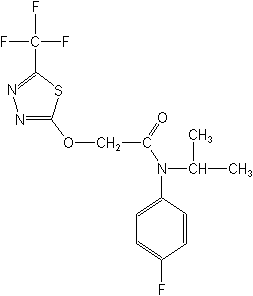-
Common NameFlufenacet
-
中文通用名氟噻草胺
-
IUPAC4′-fluoro-N-isopropyl-2-[5-(trifluoromethyl)-1,3,4-thiadiazol-2-yloxy]acetanilide
-
CASN-(4-fluorophenyl)-N-(1-methylethyl)-2-[[5-(trifluoromethyl)-1,3,4-thiadiazol-2-yl]oxy]acetamide
-
CAS No.142459-58-3
-
Molecular FormulaC14H13F4N3O2S
-
Molecular Structure
-
Category
-
ActivityFlufenacet is a herbicide intended primarily for soil application. It can be used early pre-plant, preplant surface (0-30 days before planting), shallow preplant incorporated, (mixed into the top 2-5 cm of soil before planting), pre-emergence (immediately following planting and prior to crop/weed emergence) and early post-emergence. Recommended timings vary according to crop and climate: some cereals are more sensitive to pre-emergence applications; potatoes cannot tolerate post-emergence applications; and the herbicide cannot be applied to direct-seeded rice, although transplanted rice tolerates it well. In Europe, the optimum time for application is pre-emergence. Flufenacet is taken up primarily by the roots and translocated to the meristematic tissues. It provides season-long residual control. Post-emergence treatments with flufenacet on cereals provide good weed control up to the three-leaf stage. Bayer says that flufenacet can be applied at rates 25%-50% lower than current standard graminicides.
The product Define is most effective when it is moved into the soil by rainfall after application. It can be used alone or in a tank mix combination with additional herbicides such as atrazine, Balance (isoxaflutole,W0051), Banvel, Prowl and Roundup to improve control of broadleaf weeds such as velvetleaf, common cocklebur and morningglory. The product provides partial control of annual grass/sedge weeds such as Cenchrus incertus,Cyperus esculentus, Eriochloa villosa, Panicum miliaceum, P texanum and Sorghum bicolor; and annual broadleaf weeds such as Amaranthus spp, A rudis, A tuberculatus, Ambrosia artemisiifolia, Brassica spp, Chenopodium spp, Desmodium tortuosum, Sida spinosa and Solanum ptycanthum. Define can be used in conservation, minimum or no-tillage crop production systems and may be applied as a broadcast spray up to 45 days before planting in corn.
In the Philippines, flufenacet is sold under the trade name Drago Plus (a twin-pack with bensulfuron-methyl) for the control of broadleaf weeds in transplanted rice. The product is applied 3-5 days after transplanting to flooded soil. Drago Plus is also recommended for the control of sedges, broadleaf weeds and annual grasses in seeded rice (applied 2-6 days after seeding). -
CropUseCropUses:
beans, corn (white corn, corn grown for silage and field corn grown for seed; not popcorn or sweet corn), chilli, cotton, cucumbers, ginger, peanuts, potatoes, rice, soybeans, sunflowers, tobacco, tomatoes, vegetables, watermelons
Cereals
120-240 g ai/ha
Maize
180-600 g ai/ha
Potatoes
480-600 g ai/ha
Sunflowers
480-600 g ai/ha
Rice
50-120 g ai/ha
Soybeans
480-600 g ai/ha
-
PremixFlufenacet+Diflufenican+Flurtamone
Flufenacet+diflufenicanDry Flowable (DF) ,Granule (GR) ,Water-dispersible granule (WG) ,Wettable powder (WP) ,Suspension concentrate (SC)
Premix Parters: diuron; glyphosate prometryn; MSMA; prometryn; trifluralin;
-
Physical PropertiesMolecular weight:363.34; Physical form:White to tan solid. Density:1.312 (20 °C); Melting point:75-77 °C; Vapour pressure:9 × 10-2 mPa (20 °C); Partition coefficient(n-octanol and water):logP = 3.2; Solubility:In water 56 ( pH 4), 56 ( pH 7), 54 ( pH 9) mg/l (25 °C). In acetone, dichloromethane, dimethylformamide, toluene and dimethyl sulfoxide >200, isopropanol 170, n-hexane 8.7, n 5-9. Stable to photolysis at 5.White to tan solid, mercaptan-like odor. Melting point 76-79°C. Vapor pressure 6.75 x 10-7 mm Hg at 20°C.
-
ToxicologyOral:Acute oral LD50 for male rats 1617, female rats 589 mg/ kg. Percutaneous:Acute percutaneous LD50 for rats >2000 mg/kg. Not an eye or skin irritant (rabbits). Inhalation: LC50 (4 h) for rats >3740 mg/m3 (aerosol). ADI:0.033 mg/ kg b.w.
-
Environmental Profile
Ecotoxicology:
Algae: EC50 (96 h) for Selenastrum capricornutum 0.0031 mg/l; (120 h) for Anabena flos-aquae 0.035 mg/l. In additional testing, recovery of affected algae populations has been demonst Bees: LD50 (contact) >25 μg/bee.Birds:Acute oral LD50 for bobwhite quail 1608 mg/kg. LC50 (6 d) for bobwhite quail >5317, mallard ducks >4970 ppm.Daphnia: LC50 (48 h) 30.9 mg/l.Fish: LC50 (96 h) for bluegill sunfish 2.13, rainbow trout 5.84 mg/l.Worms: LC50 (14 d) for Eisenia foetida 226 mg/ kg dry soil.Other aquatic spp.: EC50 for mysid shrimp 2.72, Lemna gibba 0.00245 ppm.
Environmental fate:
Animals:After oral administration, flufenacet is rapidly excreted by animals (rat, goat, hen); hence accumulation in organs and tissues is not to be expected. Metabolism takes place via cleavage of the molecule, followed by conjugation of the fluorophenyl moiety Soil:Aerobic DT50 34 d; secondary DT50 ?1 y ( calc.). Koc (sandy loam) 354 (range 233-613). Stable to photolysis in soil. Rapidly degraded in soil; residPlant:In maize, soya beans and cotton, flufenacet is rapidly and extensively metabolised; no parent compound was detected, even at early sampling dates.
Fate in aquatic systems:
Flufenacet is not degraded by hydrolysis at pH 5 - 9, or by photolysis in water.
The Canadian PMRA recommends buffer zones of 24 and 40 m to protect sensitive non-target terrestrial plants and aquatic organisms, respectively. -
Transport InformationHazard Class:III(Slightly hazardous)
Porduct NewsMore
New Zealand consults on Bayer’s herbicide Firebird application
Related CompaniesMore
Shandong Jingbo Agrochemicals Technology Co., Ltd.
Country: China
Pyrimethanil Pyraclostrobin Fomesafen Tebufenozide Fenoxanil Azoxystrobin Kresoxim-methyl Boscalid Nicosulfuron Emamectin benzoate Indoxacarb Quizalofop-P-ethyl
Shandong Zhongxin Kenong Biological Technology Co., Ltd
Country: China
Lambda-cyhalothrin Imidacloprid Acetamiprid Emamectin benzoate Abamectin Pymetrozine Propiconazole Iprodione Carbendazim+mancozeb Azoxystrobin+difenoconazole Diquat
Country: China
Fluroxypyr-meptyl Clodinafop-propargyl Glufosinate-ammonium Picloram Clopyralid Triclopyr-butotyl Flumioxazin Triclopyr Diquat Epoxiconazole
Country: India
Difenoconazole Propiconazole Prothioconazole Carbendazim Metconazole Flufenacet Quinclorac Quinmerac
Country: China
Carfentrazone-ethyl Flufenacet Sulfentrazone Trinexapac-ethyl Thidiazuron Thidiazuron+Diuron Carfentrazone-ethyl+Fluroxypyr Methyl

 0
0 Subscribe
Subscribe
